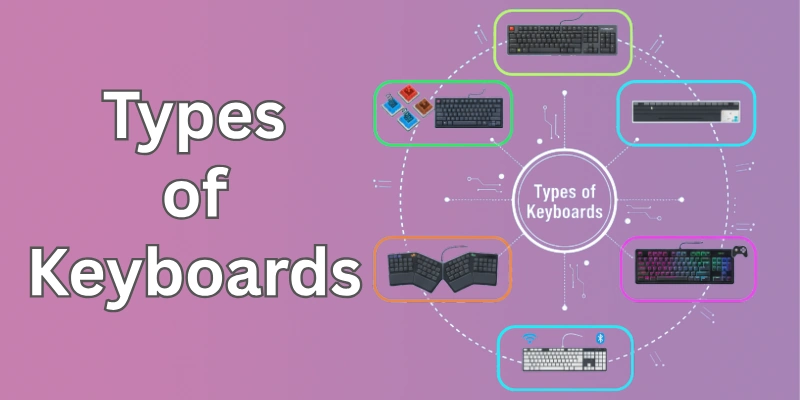Types of Keyboards: Definition, Pros, Cons & Best For!
Published: 25 Sep 2025
Keyboards have a long and interesting history. Did you know that the first keyboards were developed over a hundred years ago to help with early communication devices like telegraphs?
Today, keyboards are essential tools for using computers and other devices. In this blog post, we’ll explore different types of keyboards in detail.

We’ll look at standard keyboards, mechanical keyboards known for their touchable feedback, ergonomic keyboards designed for comfort, and more.
So, guys, let’s get started!
Keyboard Types
Here are the 40+ major types of computer keyboards:
- Standard Keyboard
- Mechanical Keyboard
- Membrane Keyboard
- Scissor-Switch Keyboard
- Rubber Dome Keyboard
- Chiclet Keyboard
- Gaming Keyboard
- Ergonomic Keyboard
- Compact Keyboard
- Tenkeyless Keyboard
- 60% Keyboard
- Wireless Keyboard
- Bluetooth Keyboard
- USB Keyboard
- Virtual Keyboard
- Projection Keyboard
- Flexible Keyboard
- Roll-Up Keyboard
- Numeric Keypad
- Multimedia Keyboard
- Macro Keyboard
- Backlit Keyboard
- Portable Keyboard
- Foldable Keyboard
- Laptop Keyboard
- Quiet Keyboard
- Split Keyboard
- Programmable Keyboard
- Trackball Keyboard
- Touchpad Keyboard
- Keyless Keyboard
- Thumb Keyboard
- One-Handed Keyboard
- Laser Keyboard
- Chorded Keyboard
- Virtual Reality (VR) Keyboard
- Multilingual Keyboard
- Washable Keyboard
- Silent Keyboard
- Industrial Keyboard
- Military Keyboard
- Medical Keyboard
- Solar-Powered Keyboard
- LED Keyboard
- OLED Keyboard
Lets cover each computer keyboard type in detail.
1. Standard Keyboard
A standard keyboard is a basic input device with a set of keys that includes letters, numbers, symbols, and function keys. It typically has 104 keys and follows the QWERTY layout.
Pros:
- Familiar layout
- Affordable
Cons:
- Basic features
- Limited customization
Best for:
- General use
- Basic typing
2. Mechanical Keyboard
A mechanical keyboard is a type of keyboard that uses individual mechanical switches for each key. These switches provide tactile feedback and audible clicks, enhancing the typing experience.
Pros:
- Durable
- Tactile (easy touch feel) feedback
Cons:
- Expensive
- Noisy
Best for:
- Typing enthusiasts
- Gamers
3. Membrane Keyboard
A membrane keyboard is a type of keyboard that uses a thin, flexible membrane layer beneath the keys. This layer registers key presses when it comes into contact with underlying circuits.
Pros:
- Quiet operation
- Cost-effective
Cons:
- Less tactile feedback
- Shorter lifespan
Best for:
- Office use
- Budget-conscious users
4. Scissor-Switch Keyboard
A scissor-switch keyboard is a type of keyboard that uses small, crisscrossing plastic pieces (like scissors) to hold keys in place. This makes the keys more stable and allows for a thinner design.
Pros:
- Quiet typing
- Slim design
Cons:
- Less key travel (keys don’t move as much)
Best for:
- Laptops
- Compact keyboards
5. Rubber Dome Keyboard
A rubber dome keyboard is a type of keyboard that uses rubber or silicone domes under each key. When you press a key, the dome collapses and completes the circuit, sending the signal to the computer.
Pros:
- Quiet typing
- Affordable
Cons:
- Less tactile feedback
- Wears out faster
Best for:
- Office use
- General typing
6. Chiclet Keyboard
A chiclet keyboard is a type of keyboard with flat, square keys that have rounded corners and a small gap between each key. The keys resemble small pieces of chewing gum, hence the name “chiclet.”
Pros:
- Easy to clean
- Modern look
Cons:
- Less tactile feedback
- Limited key travel
Best for:
- Laptops
- Sleek designs
7. Gaming Keyboard
A gaming keyboard is specifically designed for gaming enthusiasts, offering features optimized for gameplay. These keyboards often include mechanical switches for faster response times and customizable backlighting for visual appeal.
Pros:
- Mechanical switches
- Customizable keys
Cons:
- Expensive
- Noisy (depending on switch type)
Best for:
- Gamers
- Competitive gaming
8. Ergonomic Keyboard
An ergonomic keyboard is designed to reduce strain and discomfort during extended typing sessions by promoting a more natural hand position. These keyboards typically have a split or curved layout to align with the natural curve of the hands and wrists.
Pros:
- Reduces wrist strain
- Promotes comfort
Cons:
- Takes time to adjust
- Often more expensive
Best for:
- Office workers
- People with wrist issues
9. Compact Keyboard
A compact keyboard is a smaller version of a standard keyboard, designed to save space and enhance portability. It typically excludes the numeric keypad and sometimes reduces key size to fit into smaller spaces.
Pros:
- Space-saving
- Portable
Cons:
- Reduced functionality (no numeric keypad)
- Takes time to adjust to smaller keys
Best for:
- Travellers
- Limited desk space
10. Tenkeyless Keyboard
A tenkeyless (TKL) keyboard is a compact keyboard layout that excludes the numeric keypad (the “ten key” part), focusing on a more compact and streamlined design.
Pros:
- Space-saving
- More ergonomic for some users
Cons:
- Lack of numeric keypad
- Less convenient for numeric data entry
Best for:
- Gamers
- Office workers
11. 60% Keyboard
A 60% keyboard is an ultra-compact keyboard layout that minimizes size by removing non-essential keys such as the function row, navigation cluster, and numeric keypad, retaining only the alphanumeric keys, modifiers, and some essential function keys.
Pros:
- Extremely compact
- Lightweight and portable
Cons:
- Limited functionality (fewer keys)
- Requires key combinations for some functions
Best for:
- Minimalist setups
- Travellers
12. Wireless Keyboard
A wireless keyboard is a type of keyboard that connects to a computer or other devices using wireless technologies such as Bluetooth or a USB receiver. It allows for greater flexibility in positioning and reduces cable clutter.
Pros:
- Freedom of movement
- Less clutter on your desk
Cons:
- Requires batteries or charging
- Potential for connectivity issues
Best for:
- Home offices
- Presentations
13. Bluetooth Keyboard
A Bluetooth keyboard is a wireless keyboard that connects to devices such as computers, tablets, or smartphones via Bluetooth technology. It allows for wireless typing without the need for a physical cable connection.
Pros:
- Wireless connectivity
- Versatility with multiple devices
Cons:
- Requires Bluetooth compatibility
- Battery-powered (may need recharging)
Best for:
- Mobile devices
- Multi-device users
14. USB Keyboard
A USB keyboard is a standard keyboard that connects to a computer or other devices using a USB (Universal Serial Bus) cable. It provides a reliable and direct connection for data transfer and power supply.
Pros:
- Reliable connection
- No need for batteries or charging
Cons:
- Requires a physical cable
- Limited flexibility in positioning
Best for:
- Desktop computers
- Fixed workstation setups
15. Virtual Keyboard
A virtual keyboard is a software-based input device that appears on a screen, allowing users to type using a mouse, touchscreen, or other pointing device. It does not have physical keys like traditional keyboards.
Pros:
- No physical hardware required
- Portable and accessible on various devices
Cons:
- Lack of tactile feedback
- Slower typing speed for some users
Best for:
- Touchscreen devices (tablets, smartphones)
- Public terminals
16. Projection Keyboard
A projection keyboard is a virtual keyboard that uses laser or infrared technology to project a keyboard layout onto a flat surface. Users can type by pressing the projected keys, which are then registered as input.
Pros:
- Portable and compact
Cons:
- Requires a flat, non-reflective surface
Best for:
- Mobile professionals
- Presentations
17. Flexible Keyboard
A flexible keyboard is a type of keyboard made from flexible materials such as silicone or rubber, allowing it to be rolled up or folded for easy storage and portability.
Pros:
- Portable and lightweight
- Resistant to spills and dust
Cons:
- Less tactile feedback
- May feel less sturdy than traditional keyboards
Best for:
- Travellers
- Outdoor use
18. Roll-Up Keyboard
A roll-up keyboard is a flexible keyboard that can be rolled up for compact storage or transport. It typically uses silicone or rubber materials, making it durable and resistant to spills. Same as flexible keyboards.
Pros:
- Portable and lightweight
- Easy to store in small spaces
Cons:
- Less tactile feedback
- May require flat surface for optimal use
Best for:
- Travellers
- Outdoor activities
19. Numeric Keypad
A numeric keypad, also known as a numpad or ten key, is a set of keys on a keyboard or standalone device arranged in a grid layout, typically used for numeric data entry and calculations.
Pros:
- Quick numeric input
- Enhanced efficiency for data entry
Cons:
- Takes up additional space
- Not essential for all users
Best for:
- Accounting
- Data entry
20. Multimedia Keyboard
A multimedia keyboard is designed with additional keys and shortcuts specifically for controlling multimedia functions such as volume adjustment, playback control (play, pause, stop), and launching applications.
Pros:
- Dedicated multimedia controls
- Enhanced functionality for media consumption
Cons:
- May have a larger footprint
- Additional features may not be needed by all users
Best for:
- Media enthusiasts
- Home entertainment centers
21. Macro Keyboard
A macro keyboard is designed with programmable keys that can be customized to perform specific sequences of actions or commands with a single keystroke. These macros are often used to streamline complex tasks or gaming actions.
Pros:
- Customizable shortcuts
- Increases productivity or gaming efficiency
Cons:
- Can be complex to set up
- Higher cost for advanced models
Best for:
- Gamers
- Power users who perform repetitive tasks
22. Backlit Keyboard
A backlit keyboard is equipped with built-in lighting underneath or behind the keys, allowing them to be illuminated. This feature enhances visibility in low-light environments and adds aesthetic appeal.
Pros:
- Improved visibility in the dark
- Stylish appearance
Cons:
- May consume more battery power (for wireless models)
- Higher cost for some models
Best for:
- Night owls
- Gamers
23. Portable Keyboard
A portable keyboard is designed to be lightweight and compact, making it easy to carry and use in various locations. It may be wireless or wired and often prioritizes small size and durability for travel.
Pros:
- Lightweight and compact
- Easy to transport
Cons:
- May have smaller keys or reduced functionality
- Limited ergonomic features compared to larger keyboards
Best for:
- Travellers
- Mobile professionals
24. Foldable Keyboard
A foldable keyboard is a portable keyboard that can be folded or collapsed for compact storage and easy transport. It typically features a hinge or flexible material that allows it to fold into a smaller size when not in use.
Pros:
- Compact and space-saving
- Ideal for travel and storage
Cons:
- May have smaller keys or reduced key travel
- Hinges or folding mechanism may affect durability
Best for:
- Travellers
- Mobile workers
25. Laptop Keyboard
A laptop keyboard is an integrated keyboard designed specifically for laptops or notebook computers. It is compact and typically includes all standard keys, often with some keys serving dual functions through modifier keys.
Pros:
- Integrated with the laptop for seamless use
- Compact design saves space
Cons:
- May have smaller keys or reduced key travel
- Limited customization options compared to desktop keyboards
Best for:
- Laptop users
- Mobile professionals
26. Quiet Keyboard
A quiet keyboard is designed to produce minimal noise while typing, making it suitable for environments where noise levels need to be kept low, such as offices or shared spaces.
Pros:
- Low noise output
- Reduces disturbance to others
Cons:
- May have reduced tactile feedback
- Some models may sacrifice key travel for quieter operation
Best for:
- Office environments
- Libraries
27. Split Keyboard
A split keyboard is designed with its layout divided into two separate halves, often with a gap or space between them. This design allows each half to be positioned ergonomically to reduce strain on the wrists and shoulders.
Pros:
- Promotes ergonomic typing posture
- Reduces strain on wrists and shoulders
Cons:
- Takes time to adjust to the split layout
- May require more desk space than traditional keyboards
Best for:
- Users with ergonomic concerns
- Those prone to repetitive strain injuries
28. Programmable Keyboard
A programmable keyboard is equipped with software or hardware that allows users to customize and assign functions or macros to specific keys. This customization can streamline workflows, automate tasks, or enhance gaming performance.
Pros:
- Customizable keys for specific tasks or shortcuts
- Increases productivity or gaming efficiency
Cons:
- Can be complex to set up or program
- Higher cost for advanced models
Best for:
- Programmers
- Gamers
29. Trackball Keyboard
A trackball keyboard integrates a trackball or trackpad directly into the keyboard design, allowing users to control the cursor and navigate without needing a separate mouse. This setup can save space and streamline input for certain tasks.
Pros:
- Integrated cursor control
- Saves desk space
Cons:
- Requires adjustment to trackball usage
- May have limited trackball size or functionality
Best for:
- Users who prefer integrated cursor control
- Limited desk space situations
30. Touchpad Keyboard
A touchpad keyboard combines a keyboard with an integrated touchpad, allowing users to control the cursor and navigate the screen without needing a separate mouse. This setup is common on compact keyboards and laptops.
Pros:
- Integrated cursor control
- Saves desk space
Cons:
- May have smaller touchpad size or functionality
- Requires adjustment to touchpad usage
Best for:
- Laptops
- Compact keyboard setups
31. Keyless Keyboard
A keyless keyboard refers to a keyboard-like device that does not have physical keys. Instead, it uses touch-sensitive surfaces or virtual keys that can be activated by touch or gestures.
Pros:
- Sleek and modern design
- Potential for customizable layouts
Cons:
- Lack of tactile feedback
- Requires adjustment to touch-sensitive input
Best for:
- Touchscreen devices
- Users looking for minimalist designs
32. Thumb Keyboard
A thumb keyboard is designed for typing primarily with the thumbs, often used on handheld devices like smartphones or small tablets. It typically has a split layout or a compact design to facilitate easier thumb typing.
Pros:
- Optimized for thumb typing
- Compact and portable
Cons:
- Limited key size and layout
- Not suitable for extended typing sessions
Best for:
- Mobile devices
- Users who prefer one-handed typing
33. One-Handed Keyboard
A one-handed keyboard is designed to be operated with only one hand, allowing users to type efficiently using a single hand while the other hand is free for other tasks.
Pros:
- Enables one-handed typing
- Useful for users with disabilities or injuries
Cons:
- Limited key layout and functionality compared to standard keyboards
- Takes time to adjust to the single-handed operation
Best for:
- Users with limited hand mobility
- Gamers who need to use controls simultaneously
34. Laser Keyboard
A laser keyboard is a virtual keyboard that projects a keyboard layout onto a flat surface using laser technology. It detects keystrokes when fingers interrupt the projected beams.
Pros:
- Portable and compact
- Updated ones
Cons:
- Lack of tactile feedback
- Requires a flat and non-reflective surface for optimal use
Best for:
- Mobile professionals
- Presentations
35. Chorded Keyboard
A chorded keyboard is a type of keyboard that allows characters and commands to be typed by pressing multiple keys simultaneously, similar to playing chords on a musical instrument. Each combination of keys (chord) represents a different character or action.
Pros:
- Compact design
- Potential for fast typing speeds once mastered
Cons:
- Learning is required
- Limited availability and support for mainstream applications
Best for:
- Users seeking highly compact input devices
- Specialized applications like data entry
36. Virtual Reality (VR) Keyboard
A Virtual Reality (VR) keyboard is a digital keyboard interface that users interact with in virtual reality environments. It typically appears as a floating or fixed virtual keyboard that users can interact with using VR controllers or gestures.
Pros:
- Immersive typing experience in VR environments
- No physical space required
Cons:
- Limited tactile feedback
- Requires VR hardware and setup
Best for:
- VR applications and games
- Virtual workspace environments
37. Multilingual Keyboard
multilingual keyboard is designed to support typing in multiple languages or scripts, often by including additional characters, diacritics, or key layouts specific to different languages.
Pros:
- Facilitates typing in various languages without switching keyboards
- Supports diverse linguistic needs
Cons:
- Key labels may be unfamiliar for some users
- Requires familiarity with different layouts for efficient use
Best for:
- Multilingual users
- International communication
38. Washable Keyboard
A washable keyboard is designed to withstand being cleaned with water or mild disinfectants, making it easy to maintain hygiene and cleanliness.
Pros:
- Resistant to spills and dirt
- Easy to clean and sanitize
Cons:
- May have a sealed design that limits key travel
- Potentially higher cost compared to standard keyboards
Best for:
- Healthcare settings
- Environments where cleanliness is crucial
39. Silent Keyboard
A silent keyboard is designed to minimize typing noise, making it suitable for environments where quiet operation is necessary, such as offices or libraries.
Pros:
- Low noise output
- Reduces disturbance to others
Cons:
- May have reduced tactile feedback
- Variability in how “silent” different models are
Best for:
- Offices
- Shared workspaces
40. Industrial Keyboard
An industrial keyboard is designed for use in harsh environments such as factories, laboratories, or outdoor settings where keyboards may be exposed to dust, water, or extreme temperatures.
Pros:
- Rugged and durable construction
- Resistant to dust, water, and other environmental factors
Cons:
- Typically bulky and less ergonomic
- Higher cost compared to standard keyboards
Best for:
- Industrial facilities
- Outdoor applications
41. Military Keyboard
A military keyboard is a ruggedized keyboard designed for use in military applications, often in field operations or harsh environments where durability, reliability, and security are critical.
Pros:
- Rugged and durable construction
- Resistant to dust, water, and extreme temperatures
- Enhanced security features
Cons:
- Typically bulky and heavy
- Higher cost compared to standard keyboards
Best for:
- Military applications
- Aerospace and defense industries
42. Medical Keyboard
A medical keyboard is designed for use in healthcare environments such as hospitals, clinics, and medical offices. It is specially engineered to meet hygiene standards and withstand cleaning and disinfection protocols.
Pros:
- Sealed and waterproof design
- Easy to clean and sanitize
- Often includes antimicrobial coatings
Cons:
- May have reduced tactile feedback
- Higher cost compared to standard keyboards
Best for:
- Healthcare facilities
- Environments where cleanliness and hygiene are paramount
43. Solar-Powered Keyboard
A solar-powered keyboard utilizes solar panels to convert sunlight or ambient light into electrical energy, powering the keyboard and potentially charging internal batteries for extended use.
Pros:
- Environmentally friendly
- No need for batteries or external power source in well-lit environments
Cons:
- Requires adequate light for continuous operation
- Initial cost may be higher compared to standard keyboards
Best for:
- Eco-conscious users
- Outdoor and well-lit indoor environments
44. LED Keyboard
An LED keyboard is a type of keyboard that features backlighting using Light Emitting Diodes (LEDs) placed underneath or around the keys. LED keyboards often allow for customizable backlight colors and patterns.
Pros:
- Enhanced visibility in low-light conditions
- Aesthetic customization with various colors and effects
Cons:
- May consume more power, especially in RGB models
- Higher cost for advanced lighting features
Best for:
- Gamers
- Users who prefer customizable aesthetics
45. OLED Keyboard
An OLED (Organic Light Emitting Diode) keyboard is a type of keyboard that integrates OLED technology to display information directly on the keys themselves. Each key can dynamically change to show different characters, symbols, or icons based on the context or user preferences.
Pros:
- Dynamic key displays for enhanced functionality
- Potential for customizable layouts and visual feedback
Cons:
- Higher cost due to OLED technology
- Limited availability and compatibility compared to standard keyboards
Best for:
- Users requiring dynamic key displays
- Customizable interface applications
How to Choose the Best Keyboard for You
So guys, you have now learned about all the types of computer keyboards. Here is just some additional info for you — I hope these quick tips will help you too.
- Pick a keyboard that feels comfortable for long typing.
- Go for mechanical keys if you like speed and durability.
- Choose a compact size if you travel a lot with your laptop.
- Look for backlit keys if you often work in low light.
- Wireless keyboards are best if you want less cable mess.
- Check compatibility with your device before buying.
Conclusion
In this article, we’ve explored various types of keyboards, each designed to meet specific needs and preferences. From standard keyboards to innovative technologies like OLED, each type offers unique advantages and considerations.
When choosing a keyboard, consider your primary use case—whether it’s gaming, office work, or mobility. Ergonomic considerations, such as comfort and typing efficiency, are also crucial for long-term use.
And!
If you have any questions or need clarification on keyboard types discussed here, feel free to ask in the comments below. We’re here to help you find the best keyboard for your needs!
FAQs
Here are some most commonly asked questions related to the different types of keyboards:
Keyboards come in various types including standard, mechanical, membrane, ergonomic, and gaming keyboards, each designed for different uses and preferences.
Keyboards have alphanumeric keys (letters and numbers), modifier keys (Shift, Ctrl, Alt), and function keys (F1 to F12) for specific commands and shortcuts.
A keyboard is an input device used to enter data and commands into a computer or other electronic device by pressing keys that correspond to characters or functions.
The most common keyboard layouts are QWERTY, AZERTY (used in French-speaking regions), QWERTZ (used in German-speaking regions), and Dvorak (optimized for English typing efficiency).
Pros include efficient data entry and command input, while cons can include potential for typing fatigue and variability in noise levels depending on the type of keyboard.
The QWERTY keyboard layout is the most common worldwide, featuring a standard arrangement of keys optimized for typing efficiency in English and many other languages.

- Be Respectful
- Stay Relevant
- Stay Positive
- True Feedback
- Encourage Discussion
- Avoid Spamming
- No Fake News
- Don't Copy-Paste
- No Personal Attacks

- Be Respectful
- Stay Relevant
- Stay Positive
- True Feedback
- Encourage Discussion
- Avoid Spamming
- No Fake News
- Don't Copy-Paste
- No Personal Attacks





